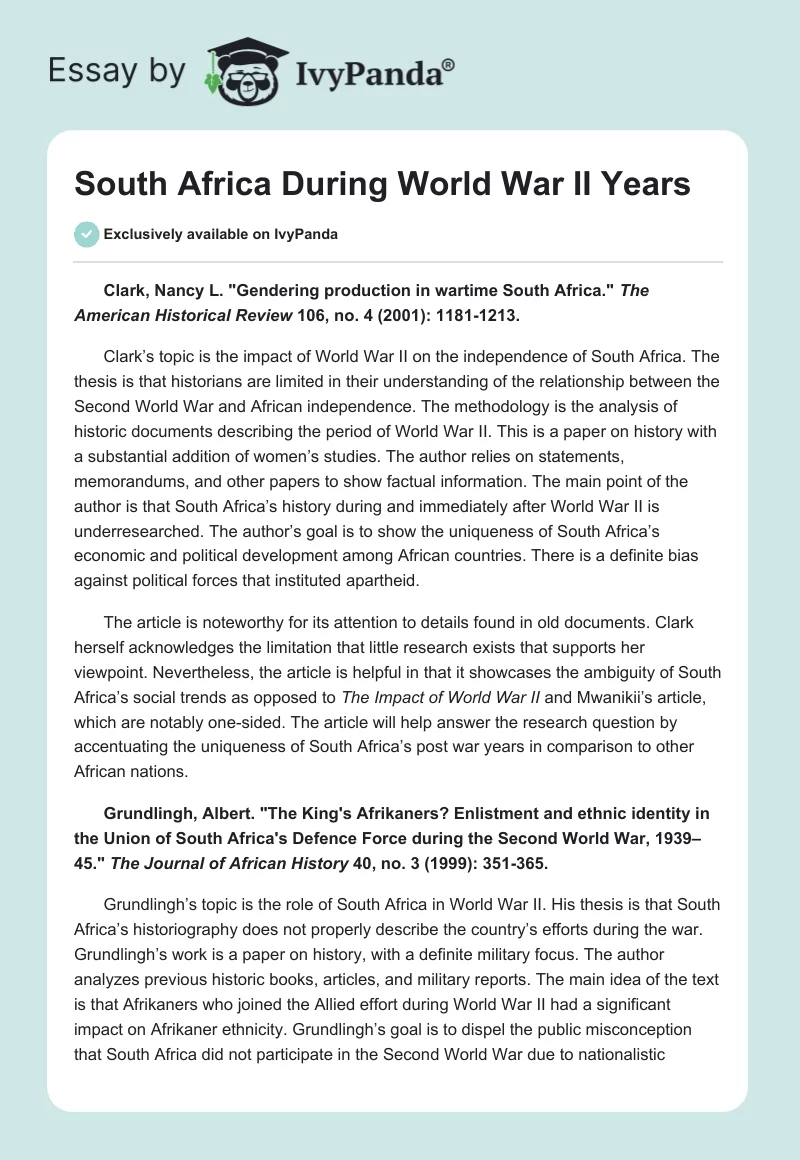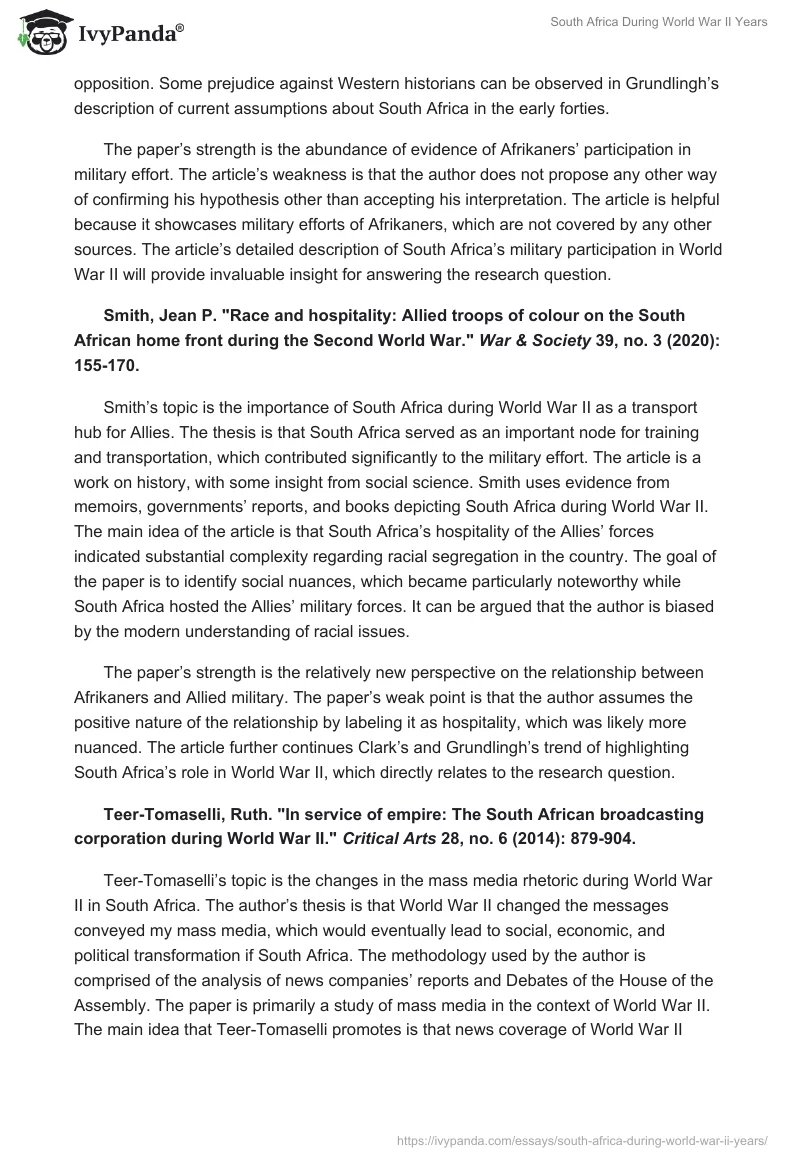Clark, Nancy L. “Gendering production in wartime South Africa.” The American Historical Review 106, no. 4 (2001): 1181-1213.
Clark’s topic is the impact of World War II on the independence of South Africa. The thesis is that historians are limited in their understanding of the relationship between the Second World War and African independence. The methodology is the analysis of historic documents describing the period of World War II. This is a paper on history with a substantial addition of women’s studies. The author relies on statements, memorandums, and other papers to show factual information. The main point of the author is that South Africa’s history during and immediately after World War II is underresearched. The author’s goal is to show the uniqueness of South Africa’s economic and political development among African countries. There is a definite bias against political forces that instituted apartheid.
The article is noteworthy for its attention to details found in old documents. Clark herself acknowledges the limitation that little research exists that supports her viewpoint. Nevertheless, the article is helpful in that it showcases the ambiguity of South Africa’s social trends as opposed to The Impact of World War II and Mwanikii’s article, which are notably one-sided. The article will help answer the research question by accentuating the uniqueness of South Africa’s post war years in comparison to other African nations.
Grundlingh, Albert. “The King’s Afrikaners? Enlistment and ethnic identity in the Union of South Africa’s Defence Force during the Second World War, 1939–45.” The Journal of African History 40, no. 3 (1999): 351-365.
Grundlingh’s topic is the role of South Africa in World War II. His thesis is that South Africa’s historiography does not properly describe the country’s efforts during the war. Grundlingh’s work is a paper on history, with a definite military focus. The author analyzes previous historic books, articles, and military reports. The main idea of the text is that Afrikaners who joined the Allied effort during World War II had a significant impact on Afrikaner ethnicity. Grundlingh’s goal is to dispel the public misconception that South Africa did not participate in the Second World War due to nationalistic opposition. Some prejudice against Western historians can be observed in Grundlingh’s description of current assumptions about South Africa in the early forties.
The paper’s strength is the abundance of evidence of Afrikaners’ participation in military effort. The article’s weakness is that the author does not propose any other way of confirming his hypothesis other than accepting his interpretation. The article is helpful because it showcases military efforts of Afrikaners, which are not covered by any other sources. The article’s detailed description of South Africa’s military participation in World War II will provide invaluable insight for answering the research question.
Smith, Jean P. “Race and hospitality: Allied troops of colour on the South African home front during the Second World War.” War & Society 39, no. 3 (2020): 155-170.
Smith’s topic is the importance of South Africa during World War II as a transport hub for Allies. The thesis is that South Africa served as an important node for training and transportation, which contributed significantly to the military effort. The article is a work on history, with some insight from social science. Smith uses evidence from memoirs, governments’ reports, and books depicting South Africa during World War II. The main idea of the article is that South Africa’s hospitality of the Allies’ forces indicated substantial complexity regarding racial segregation in the country. The goal of the paper is to identify social nuances, which became particularly noteworthy while South Africa hosted the Allies’ military forces. It can be argued that the author is biased by the modern understanding of racial issues.
The paper’s strength is the relatively new perspective on the relationship between Afrikaners and Allied military. The paper’s weak point is that the author assumes the positive nature of the relationship by labeling it as hospitality, which was likely more nuanced. The article further continues Clark’s and Grundlingh’s trend of highlighting South Africa’s role in World War II, which directly relates to the research question.
Teer-Tomaselli, Ruth. “In service of empire: The South African broadcasting corporation during World War II.” Critical Arts 28, no. 6 (2014): 879-904.
Teer-Tomaselli’s topic is the changes in the mass media rhetoric during World War II in South Africa. The author’s thesis is that World War II changed the messages conveyed my mass media, which would eventually lead to social, economic, and political transformation if South Africa. The methodology used by the author is comprised of the analysis of news companies’ reports and Debates of the House of the Assembly. The paper is primarily a study of mass media in the context of World War II. The main idea that Teer-Tomaselli promotes is that news coverage of World War II brought about changes in public perception, which would eventually lead to the demise of British rule in South Africa.
The author’s intent is to showcase the power of mass media in tipping the narrative. No clear biases are evident as Teer-Tomaselli outlays facts with little personal opinion. The text’s strength is its reliance on state documents to prove the author’s point. The paper’s disadvantage is that no real interpretation of qualitative is given. This piece is valuable because it is the only source that addresses the role of mass media. Understanding the role of the mass media is helpful in answering the overall research question.
Mwanikii. “The Unspoken Contributions of South Africa in WWII,”Medium.
The topic is the necessity of recognition of South Africa’s contribution the Allies during World War II. The author’s thesis is that the acknowledgement of the role of Western powers in World War II should also include South Africa’s contribution. The author analyzes excerpts from a history book and scholarly journal article, both of which are dedicated to South Africa’s involvement in the World War II. Although the article’s focus is history, it is in reality an opinion piece. The main idea is that South Africa’s contribution allowed Western nations to secure victory, which is not properly acknowledged by modern historiography.
The author’s goal is to acquaint the audience with the basic facts known about Afrikaners’ involvement in the World War II. The author openly expresses his bias against Western historiography’s coverage of the World War II. This opinion piece is valuable because it succinctly highlights basic facts about South Africa during the World War II. The main weakness is that the author is biased and does not acknowledge the numerous nuances evident in the works of other researchers. This article is helpful in answering the research question because it serves as an overview of all important knowledge gaps about South Africa’s role in the World War II.
“The Impact of World War II,”Country Studies.
The Impact of World War II is an entry from a South Africa: A Country Study by Rita M. Byrnes. The title is self-explanatory – it details the aftermath of the World War II in South Africa. No clear thesis is presented as the entry is an account of events. Byrnes relies on the sources approved by the US Library of Congress to convey her ideas. The work itself is a mix of history with social sciences with an emphasis on racial controversies. Byrnes’ main point is that the World War II has accentuated social and economic issues in South Africa, which would lead to the emergence of black workers’ protests.
The goal is to identify the origins of the racism-related protests in the aftermath of the World War II. This source is important because it showcases the US view of South Africa during the World War II, which is limited compared to other sources. The main limitation of the study is the absence of any references to the actual South African documents. This source also ignores the complexity of South Africa’s contributions to the war effort accentuated by Mwanikii, Clark, Grundlingh, Smith, and Teer-Tomaselli. This entry is invaluable to answering the research question as it showcases the gaps in Western historiography regarding South Africa during and after the World War II.


